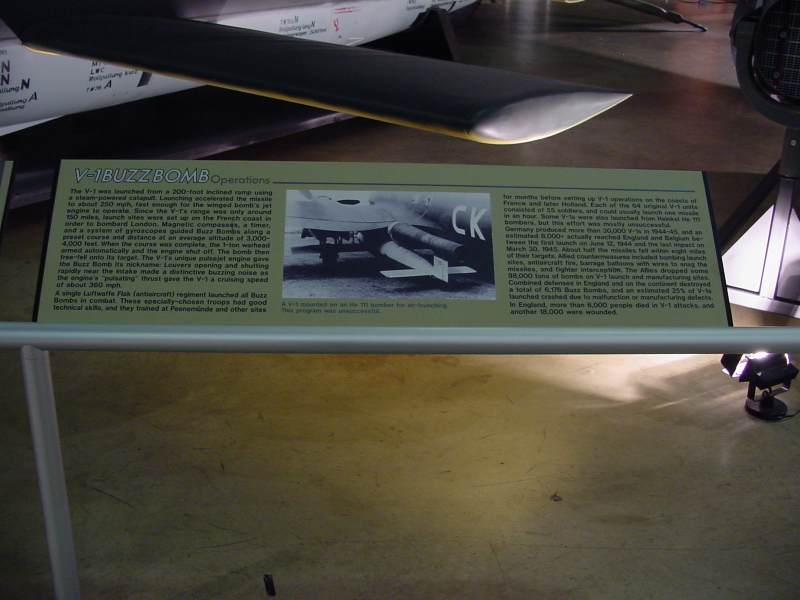| Prev |
heroicrelics.org Air Force Museum Site Index JB-2 Loon/V-1 Gallery |
Next |
dsc20309.jpg
One of the signs accompanying the buzz bomb. It reads
V-1 Buzz Bomb Operations
The V-1 was launched from a 200-foot inclined ramp using a steam-powered catapult. Launching accelerated the missile to about 250 mph, fast enough for the winged bomb's jet engine to operate. Since the V-1's range was only around 150 miles, launch sites were set upon the French coast in order to bombard London. Magnetic compasses, a timer, and a system of gyroscopes guided Buzz Bombs along a preset course and distance at an average altitude of 2,000-4,000 feet. When the course was complete, the 1-ton warhead armed automatically and the engine shut off. The bomb then free-fell onto its target. The V-1's unique pulsejet engine gave the Buzz Bomb its nickname: Louvers opening and shutting rapidly near the intake made a distinctive buzzing noise as the engine's "pulsating" thrust gave the V-1 a cruising speed of about 360 mph.
A single Luftwaffe Flak (antiaircraft) regiment launched all Buzz Bombs in combat. These specially-chosen troops had good technical skills, and they trained at Peenemünde and other sites for months before setting up V-1 operations on the coasts of France and later Holland. Each of the 64 original V-1 units consisted of 55 soldiers, and could usually launch one missile in an hour. Some V-1s were also launched from Heinkel He 111 bombers, but this effort was mostly unsuccessful.
Germany produced more than 30,000 V-1s in 1944-45, and an estimated 8,000+ actually reached England and Belgium between the first launch on June 12, 1944 and the last impact on March 30, 1945. About half the missiles fell within eight miles of their targets. Allied countermeasures included bombing launch sites, antiaircraft fire, barrage balloons with wires to snag the missiles, and fighter interception. The Allies dropped some 98,000 tons of bombs on V-1 launch and manufacturing sites. Combined defenses in England and on the continent destroyed a total of 6,176 Buzz Bombs, and an estimated 25% of V-1s launched crashed due to malfunction or manufacturing defects. In England, more than 6,000 people died in V-1 attacks, and another 18,000 were wounded.

| Time picture taken | Fri Oct 20 09:06:55 2006 |
| Location picture taken | Air Power Gallery Air Force Museum Dayton, OH |
| Prev | JB-2 Loon/V-1 Gallery | Next |